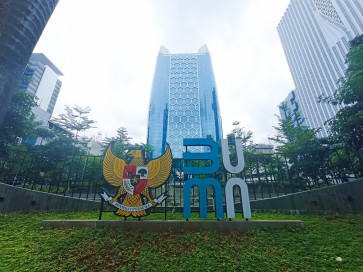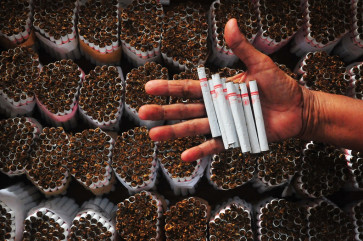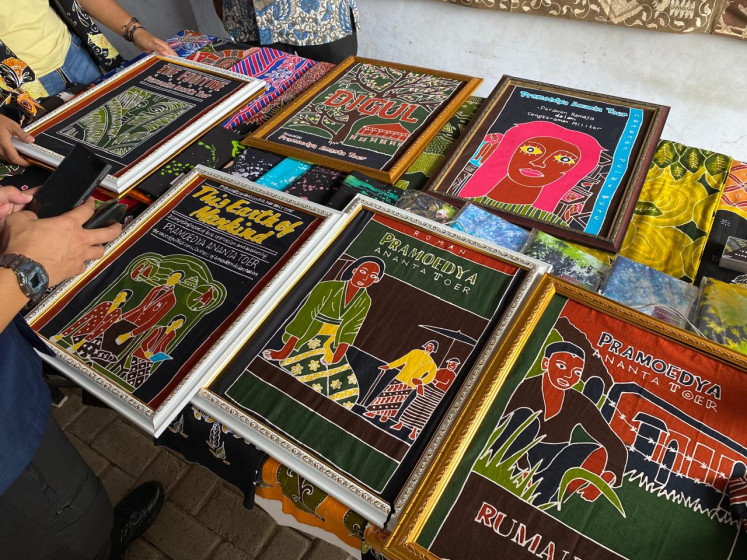Popular Reads
Top Results
Can't find what you're looking for?
View all search resultsPopular Reads
Top Results
Can't find what you're looking for?
View all search resultsKafka was a vegetarian
American writer Jonathan Safran Foer is probably the only writer I know who quotes German writer Franz Kafka and French postmodern thinker Jacques Derrida in his argument in support of vegetarianism
Change text size
Gift Premium Articles
to Anyone
A
merican writer Jonathan Safran Foer is probably the only writer I know who quotes German writer Franz Kafka and French postmodern thinker Jacques Derrida in his argument in support of vegetarianism.
In his new book Eating Animals (his third after the two award-winning and best-selling fictions Everything is Illuminated and Extremely Loud and Incredibly Close) Safran traces the roots of modern vegetarianism in the works of some of the world’s literature greats.
For example, Safran quotes Kafka’s estate keeper Max Brod about the moment when the writer became a vegetarian:
“Now at least I can look at you in peace. I don’t eat you anymore. That was the time that [Kafka] became a strict vegetarian,” Kafka said to Brod after seeing a fish swimming in an aquarium at the the Berlin Zoo.
Behind that simple statement lies a difficult ethical question, that when we consume animal products, we in fact disavow a part of our nature. In fish, we can still recognize parts of ourselves — spines, pain receptors, endorphins (which relieve pain) and all of the familiar pain responses — and by eating them, we therefore deny important parts of our humanity, Safran says, paraphrasing Kafka.
Clearly, this is a powerful statement from Kafka, whose greatest work is Metamorphosis, published in 1915, which is his story of waking up in the morning and finding out he has turned into a bug.
From Derrida, Safran Foer learns that those who consume animal products violate not only animals but also the sentiment of compassion and “on the other hand those who appeal for an irrefutable testimony to pity”.
But quoting big names in literature and presenting their ethical conundrums in consuming meat will likely do little to encourage carnivorous readers to become vegans.
In its early passages, Eating Animals drags on a little as Safran presents his verbiage-heavy mission, but the latter parts of the book are a presentation of a convincing case against consuming animal products, backed by relentless field research, investigative work, countless interviews with farmers and American corporate bigwigs and data he collected from the government, watchdogs and the farm industry.
And all the hard works is to show us that the biggest sin we commit when we consume an animal product is the act of condoning cruelty to animals.
The wealth of data from scientific experiments, Safran argues, may have failed to describe precisely the extent of suffering that animals go through when they are crammed into factory farms or when they are being slaughtered, but the undeniable fact is (remember that Safran drew from Kafka that animals are part of our being) animals can feel this suffering, and the debate over the intensity of this suffering is beside the point.
That each animal may wear that frightened stare is in fact the penultimate of a long line of suffering that animals have to go through in the process of bringing a slice of steak, fried drum stick or roll of sushi to our dinner table.
In one of the farms Safran (secretly) visited for this book, he found more than 33,000 birds were kept in one shed only 45-feet wide and 490-feet long. “You don’t have to see it for yourself, or even do the math, to understand that things are packed pretty tight,” Safran Foer says.
In a description that will effectively kill your appetite for eating white meat, Safran Foer writes that the genetic engineering has enabled chickens to grow muscles and fat tissue significantly faster than their bones, something that leads to deformities and disease.
“Excess fluids fill the body cavities, ascites kills even more [5 percent of birds globally]. Three out of four will have some degree of walking impairment, and common sense suggests they are in chronic pain,” Safran writes.
The worst forms of suffering, however, are in fact deliberately caused by farm workers, he says. Safran found that in “a supplier farm for Kentucky Fried Chicken [KFC] and Tyson Food, two of America’s largest chicken growers and suppliers, fully conscious chickens were kicked, stomped on, slammed into walls, had chewing tobacco spat in their eyes, and literally had their s*@t squeezed out of them and their beaks ripped off.”
Other farmed animals are no less fortunate, he writes.
Pigs raised in factory farms, forced to live in a crowded pens, showed weakened bones, urinary infections, cardiovascular problems and a reduction in muscle mass so severe it affected the animals’ ability to lie down, Safran writes in a chapter titled “Slices of Paradise/Pieces of S*@t.”
“Other studies indicate that poor genetics, lack of movement [due to limited space] and poor nutrition leave 10 to 40 percent of pigs structurally unsound, with buckling of the knees, bowed legs and pigeon toes … many piglets are born with deformities such as cleft palate, hermaphroditism, inverted nipples, no anus, splayed legs, tremors and hernia,” he writes.
To make life even more miserable for these animals, every year they have to be injected with loads of antibiotics to sustain their miserable lives, simply because they are no longer capable of surviving in the disease-ridden environment.
“Livestock are fed nearly £28 million [more than the amount used on human beings], according to the drug industry … Officials at many health organizations, including the Center for Disease Control, have called for an end to the indiscriminate use of antibiotics on farms, but, of course, the practice continues,” he writes.
As a result we have witnessed the birth of drug-resistant diseases or “superbugs” that not only kill animals but have also infected (and killed) humans.
“The primary ancestor of the recent H1N1 swine flu outbreak originated at a hog factory farm in America’s most hog-factory-rich state, North Carolina, and then quickly spread throughout the Americas,” Safran writes.
At the very end of their lives, these animals have to bear a terrible amount of suffering. During the slaughtering process, chickens are dragged through the stunner and pigs are electrocuted and cows have bolts shot into their heads. (In many cases, the cows are not killed immediately by the bolts, and so remain conscious as they are skinned and dismembered.)
Who is to blame for all of this?
Before pointing his finger at us, meat consumers, Safran places a large part of the blame on large corporations such as Tyson Food, KFC and America’s largest hog factory farm, Smithfield. These conglomerates control much of the supply of meat in the United States, if not the world.
And before these companies are found guilty of committing cruelty against animals, they are responsible for creating a myth that eating meat and consuming dairy products are healthy choices.
This conventional wisdom, however, has been repeatedly challenged.
The American Dietic Association, since the 1990s, has issued reports that well-planned vegetarian diets are appropriate for all individuals during all stages of life, including pregnancy, lactation, infancy, childhood, and adolescence, and for athletes. Other data suggests that excess animal protein intake is linked to osteoporosis, kidney diseases, calcium stones in the urinary tract, and some cancers.
So what are the options for us? Safran is well aware that his book alone will not be enough to convince people to change their eating habits (I turned vegetarian after reading this, but I don’t know for how long), but for those who can’t stop their craving for meat, he proposes a saner and less-cruel alternative in the form of traditional pasture farming — which in America contributes roughly 2 percent of all animal products.
“With feedlot-raised beef, the industry offends me less and 100 percent pasture-raised beef, setting aside the issue of slaughter for a moment, is probably the least troubling of all meats,” Safran writes.
I find this an ambiguous stance on vegetarianism and a little troubling. But by setting aside the issue of traditional farming for a moment and focusing on the cruelty and the disastrous consequences of factory farming, I consider this book persuasive case for vegetarianism.
I don’t know for sure how cruel and harmful factory farms are in Indonesia, but believe it is safe to assume that the same thing occurs here. When it comes to profit, most companies would be
willing to go an extra mile to torture animals for the meat, milk and eggs that will sit in our fridges conveniently for our consumption.
While this book — with its no-nonsense, matter-of-fact title — did not make me a vegan activist (Hollywood starlet Natalie Portman turned vegan activist after reading it), from now on I will keep an eye on what my daughter consumes much more closely.
Eating Animals
Jonathan Safran Foer
Hamish Hamilton, 2009
341 pages










